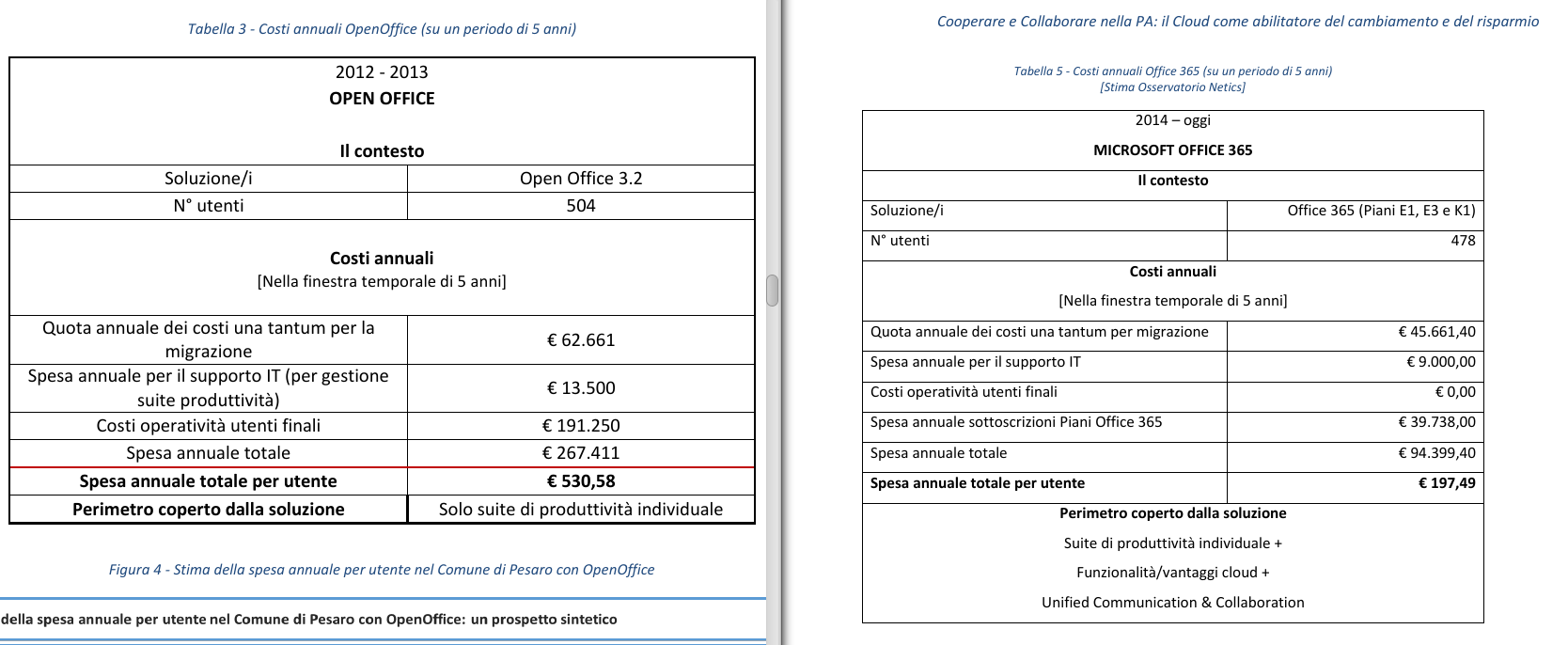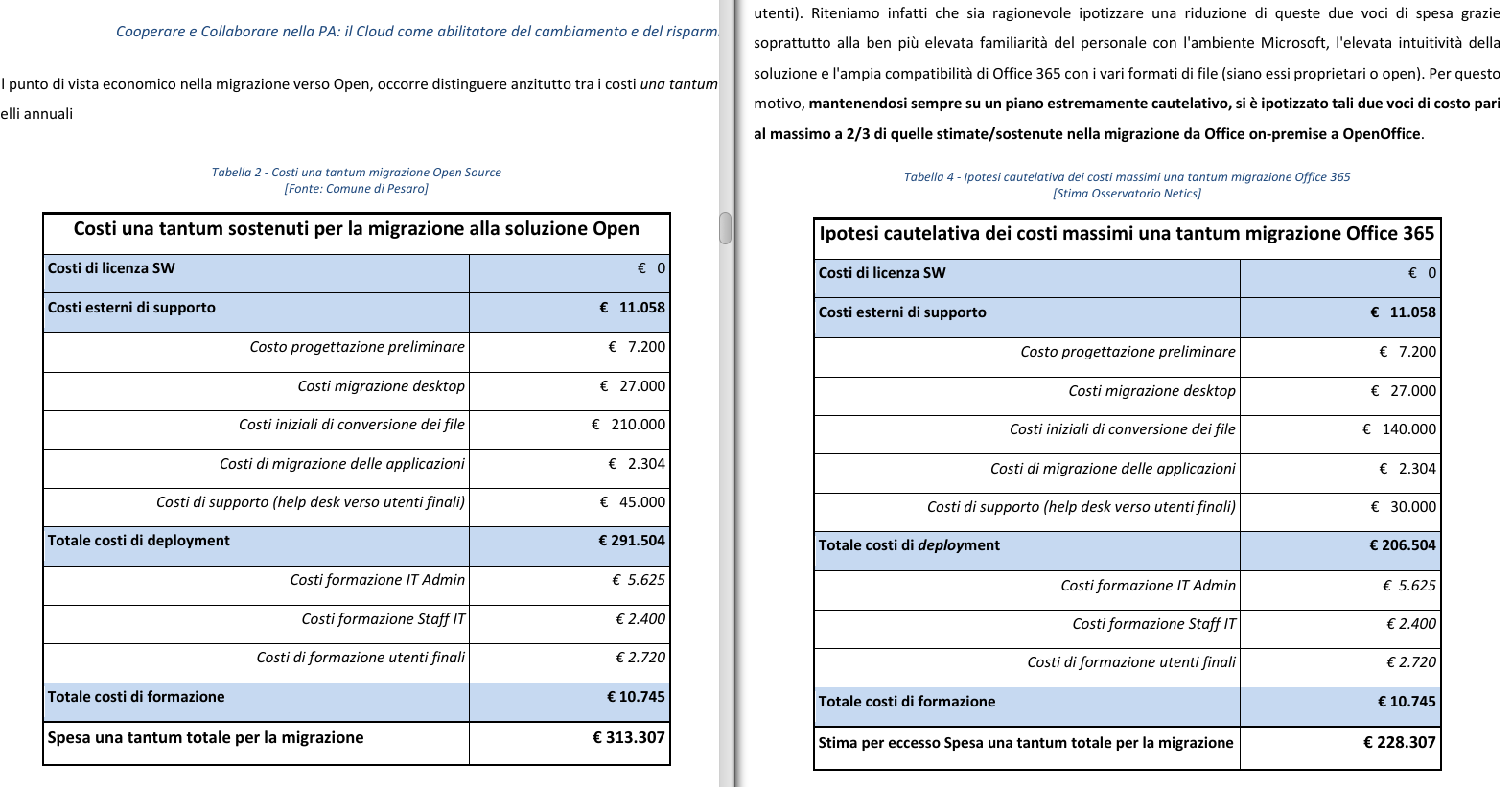Microsoft vs OpenOffice in Pesaro: first, let's recap

Pesaro is a town of about 100 thousands people on the northern adriatic coast of Italy. Its Public Administration has been facing lots of critics from Free/Open Source software supporters because, in the last five years, it changed twice the same, important part of its ICT infrastructure. Both those changes bring consequences and open issues, both for the critics and for Pesaro, that have had little or no coverage at all so far, especially outside Italy (1). Before talking about them, however, it is necessary to summarize what happened.
The first move was the migration, in 2010/2011 of 504 desktops from Microsoft Office to OpenOffice. The second, decided in November 2014, was a U-turn: sorry, we were wrong, let's migrate to the latest and greatest from Microsoft, that is Office 365, to do lots of things better, even working in teams and online.
Today's critics come both on the functional reasons of the return to Office, which an italian commenter described as "they just said whatever came up first in their brains", and on the economic ones, which were made public only six/seve months after the decision, inside a report funded by Microsoft. From that report it looks like:
First, the actual costs for OpenOffice training in 2011 were the same as the maximum declared for Office 365 training in the new migration. A fact that, joking, we may also consider as an official confirmation, from Microsoft itself, that switching to Open or Libre Office is not more expensive, as far as training is concerned, than switching version of Microsoft Office. But I'll get back to this in another article.
Second, the studies to prepare the migration to OpenOffice were bad, the implementation worst and not even completed. On the training side, there were reports of "just a short presentation of Open Source and OpenOffice in late 2010, and one short course in late 2011″. Besides that, the Administration discovered that water is wet, but only by crossing the river, instead of actually looking at it before. Basically, city employees and sysadmins discovered only after migrating to OpenOffice that the Town of Pesaro, like 90% of Public Administrations and other great organizations worldwide, fights against software and itself, because:
- they use(d) office suites terribly: they had LOTSof horribly formatted documents, macros of questionable necessity and spreadsheet or MS Access files spread all over the places as poor surrogates for real databases
- they used office suites embedded in, or interacting with, other custom software, mostly made to order to interact only with Microsoft products
- if you migrate from a wheelbarrow to a truck, but move it by pushing, you'll move slower than before. In other words, if you only change software, but keep using it in the same old ways, that may have been obsolete ten years ago, little will change (usually, for the worst)
Third, this is not even a comparison between apple and oranges, but between apples and fruit salad, home delivered. Office 365 does much more than OpenOffice or Libre Office, and this cannot be ignored. Of course, if one can or wants to eat only apples anyway, he'd better not buy the fruit salad.

Fourth, costs, and where they end up. The money that Pesaro spent (badly) on OpenOffice at least remained, I suppose, mostly in Italy, to benefit italian tax office and workers. Microsoft, instead, pays VAT in Ireland. This said, let's look at some figures. Pesaro did a U-turn because, says the report mentioned above, using OpenOffice cost 530 Euros per employee/year, while Office 365 should only cost 197, which become 112 once you factor in the 85 Euros saved on phone calls, business trips and other activities, thanks to the teamwork features and cloud support of that suite.
530 Euros vs 112. No match here, is it? No, if that is the match to play, but let's go one step at a time. First, we need to consider that:
- the cost calculations in the report do not consider any possible price increase from Microsoft. That's OK, since even Open Source suppliers would increase their prices, over five years… as long as who must buy remembers that the price increases that a monopolist can afford are not the same that whoever works in a more open market would dare
- it really is 530 Euros vs 112 only if the time wasted to fight against software, as said above, is the cost of reduced operativity due to OpenOffice ("costi di operatività" in table 3 of the report) really is THREE HUNDRED EIGHTY Euros (191250/504) for OpenOffice, and ZERO for Office 365. But if that is the case, both those figures are "dishonest", each in a different way. A software program that in FIVE years doesn't make you lose ONE Euro for those reasons is the Genie of the Lamp, not a product of this world
- each employee of Pesaro wasted 380 Euros per year to fight the problems above? I believe that without any effort, but please look at those problems. Blessed are those who have not seen (that is, actually endured any change of office suite in those conditions) and yet have believed that software must be used properly, and only after fixing brains and procedures. Those are almost all problems that OpenOffice only brought to daylight, caused by resistance to change, or lack of competence. There is little there that is OpenOffice fault, even if OpenOffice does have flaws. Above all, as long as staff and management remain the same, doing the same things, it's hard to believe that those costs will drop to ZERO by just changing software.
- subtracting from the 197 Euros that Office 365 would cost as mere office suite the 85 Euros saved on phone calls, business trips etc, is correct, in my opinion: apples vs home-delivered fruit salad, remember? But is correct only if, at the same time, one also does add the cost of the home delivery. The cost, that is, of newer hardware and connectivity, since at least the second voice is unavoidable if everybody is to work through the cloud as promised. Where are those costs?
Final question (for now)
 There is one thing I haven't understood. This interview says that (emphasis mine):
There is one thing I haven't understood. This interview says that (emphasis mine):
the expense of using OpenOffice from 2010 to 2014 was 300K Euros, of which 210K estimated as follows: in the four years considered, moving from one suite to another showed to be very expensive, in terms of time spent converting files, rewriting macros and much more, resulting in one full person-day per year, for 350 employees.
From that estimate, and using 150 Euros as average cost of one person/day (both numbers feel fine to me) we obtain exactly 210K Euros (350*4*150). But the parts in bold in the quote above had led me to believe that they were talking of what, in the report tables, is called costs for lost operativity recurring each year ("costi operatività utenti finali"). The only "210K" in the report, instead, is already included in another row of the same tables, the one called "quota annuale dei costi una tantum per la migrazione" that is "yearly quote of the una tantum cost of migration". Now, unless the same cost was added twice (and calculating it in different ways each time), where do the "costs for lost operativity recurring each year" come from, especially considering that they are three times higher than the "una tantum" part? Again, I'm not sure about this part. Of course I'll let you know when I get explanations.
End of the first half
The first image of this post comes from an article commenting the fact that, just in the 2014/2015 season, the soccer team of Pesaro gained… "the second relegation of the new century". Too good a coincidence to not use it.
We have seen that all the costs and data published so far must be explained better, and used with careful consideration. As far as I am concerned, however, they already confirm what I said at the beginning: both migrations bring consequences and open issues, both for the critics and for Pesaro, that still must be discussed. I'll do that in the next post, so stay tuned.
(1) The reports at Tech Republic and JoinUp are based only on some of the earliest italian analyses and comments on the migration
Who writes this, why, and how to help
I am Marco Fioretti, tech writer and aspiring polymath doing human-digital research and popularization.
I do it because YOUR civil rights and the quality of YOUR life depend every year more on how software is used AROUND you.
To this end, I have already shared more than a million words on this blog, without any paywall or user tracking, and am sharing the next million through a newsletter, also without any paywall.
The more direct support I get, the more I can continue to inform for free parents, teachers, decision makers, and everybody else who should know more stuff like this. You can support me with paid subscriptions to my newsletter, donations via PayPal (mfioretti@nexaima.net) or LiberaPay, or in any of the other ways listed here.THANKS for your support!